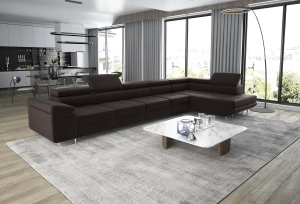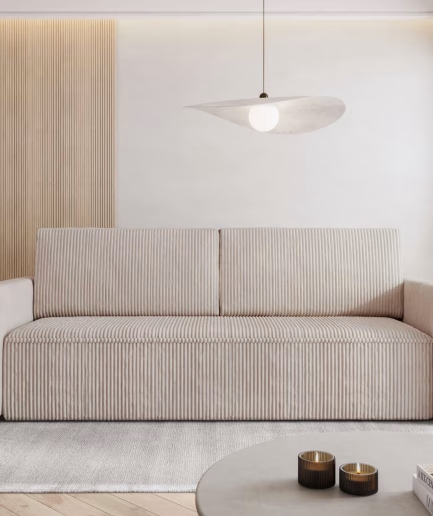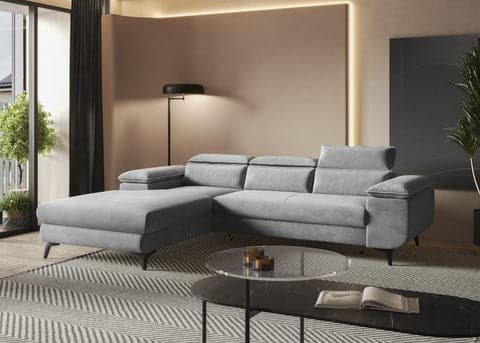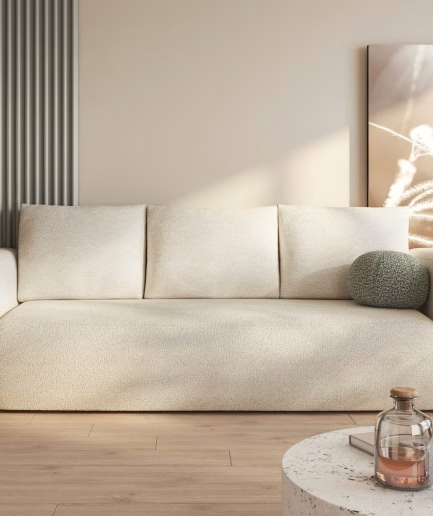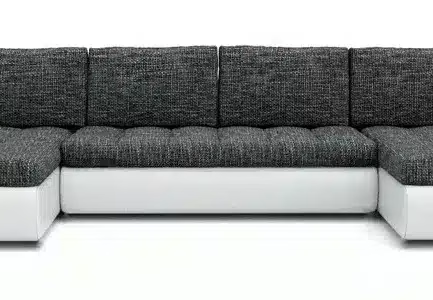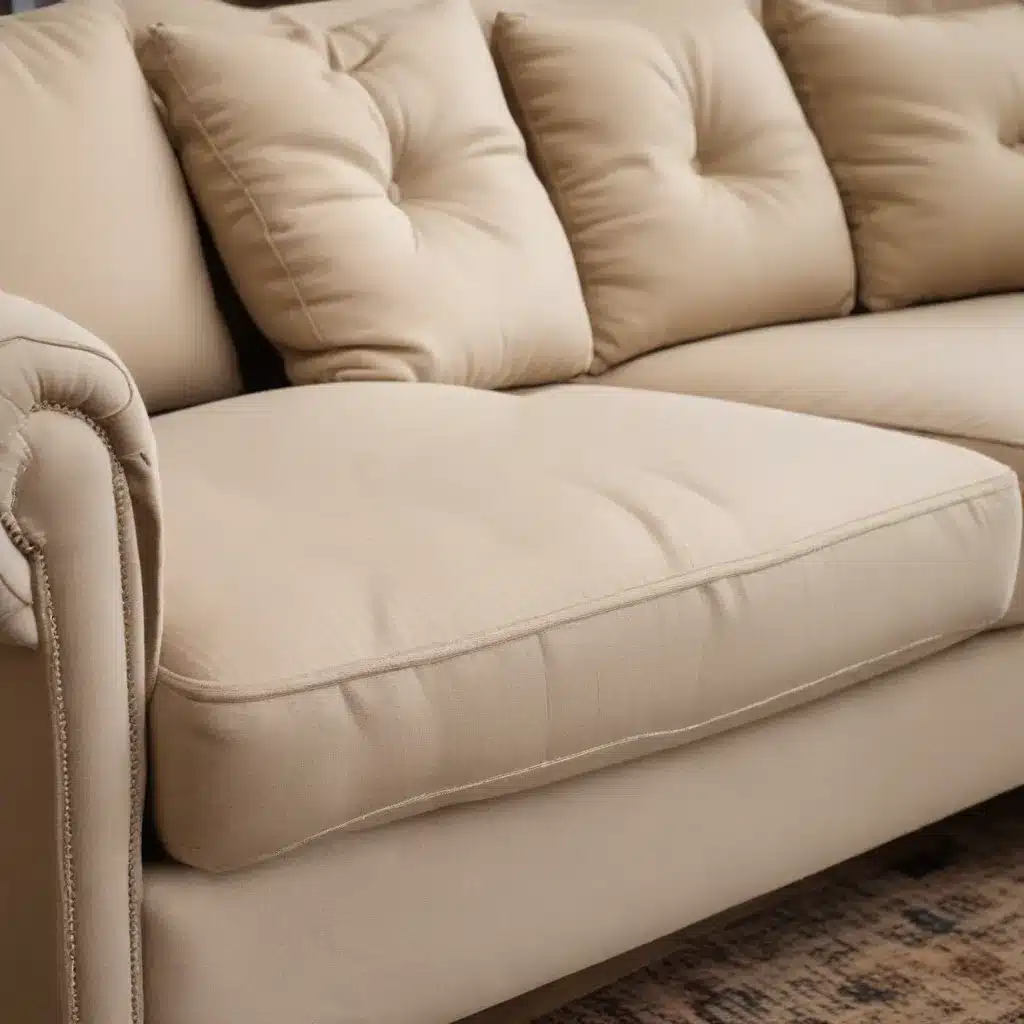
The Art of Selecting the Perfect Sofa
As a furniture specialist with years of experience, I’ve seen countless homeowners struggle with choosing the right sofa for their living spaces. It’s not just about picking a pretty piece – it’s about finding that perfect balance between aesthetics, comfort, and practicality.
When I’m guiding clients through the selection process, I always start by asking them to consider their lifestyle. Do they have young children or pets? Are they entertained frequently? These factors play a crucial role in determining the best upholstery material and sofa style.
For instance, I once worked with a family of five who loved hosting movie nights. We opted for a large sectional with performance fabric that could withstand spills and constant use. The result? A cozy, durable seating arrangement that became the heart of their home.
Another key aspect I emphasize is the sofa’s scale in relation to the room. I’ve seen too many beautiful sofas overwhelm small spaces or get lost in larger ones. My rule of thumb? Leave at least 18 inches of walking space around the sofa. This ensures a good flow and prevents the room from feeling cramped.
Color selection is another area where I see many homeowners hesitate. While neutral tones are always safe, I often encourage clients to consider bolder hues or patterns. A vibrant sofa can serve as a stunning focal point, especially in minimalist interiors. However, if you’re unsure about committing to a bold color, consider using vibrant throw pillows or a colorful throw blanket to add pops of color to a neutral sofa.
Upholstery Maintenance: Keeping Your Sofa Looking Spectacular
Once you’ve selected the perfect sofa, the next challenge is maintaining its beauty over time. As someone who’s dealt with countless upholstery issues, I can’t stress enough the importance of regular care.
First and foremost, vacuum your sofa weekly. This simple task removes dust, crumbs, and other particles that can work their way into the fabric and cause premature wear. Use the upholstery attachment and go over the entire surface, including the crevices and under the cushions.
Spills are inevitable, but how you handle them can make all the difference. I always advise clients to blot – never rub – spills immediately. Rubbing can push the stain deeper into the fabric or spread it further. For water-based spills, a clean, damp cloth is usually sufficient. For oil-based stains, a small amount of dish soap mixed with water can work wonders.
One of my favorite maintenance tips is using arm covers. These not only protect high-wear areas but can also add a decorative touch to your sofa. I’ve seen clients use everything from elegant lace to rustic burlap, depending on their style preferences.
For leather sofas, conditioning is key. I recommend applying a high-quality leather conditioner every 6-12 months to keep the material supple and prevent cracking. Always test any product on a hidden area first to ensure it doesn’t discolor the leather.
Trends in Sofa Design: Balancing Style and Comfort
As someone deeply immersed in the furniture industry, I’ve witnessed numerous design trends come and go. However, one constant remains: the desire for both style and comfort in living room seating.
In recent years, I’ve noticed a shift towards more relaxed, informal sofa designs. Overstuffed cushions, deep seats, and low profiles are gaining popularity. These designs cater to our increasing desire for comfort and coziness in our homes.
Modular sofas are another trend that’s here to stay. I love recommending these to clients because of their versatility. They can be rearranged to suit different room layouts or social situations. I recently helped a client select a modular sectional that could be split into individual chairs for parties – talk about flexible seating!
In terms of upholstery, performance fabrics are becoming increasingly sophisticated. Gone are the days when durable meant sacrificing style. Today’s performance fabrics come in a wide range of textures and colors, offering both stain resistance and aesthetic appeal.
Sustainability is also influencing sofa design. I’m seeing more manufacturers use eco-friendly materials like organic cotton, recycled polyester, and sustainably sourced wood frames. For environmentally conscious clients, I often suggest looking for certifications like FSC (Forest Stewardship Council) for wood components.
The Impact of Color: Choosing the Right Hue for Your Sofa
Selecting the right color for your sofa can dramatically influence the overall feel of your living space. As a furniture specialist, I’ve guided countless clients through this crucial decision, and I’ve learned that it’s about more than just personal preference.
When considering color, it’s essential to think about the mood you want to create in your room. Cool tones like blues and greens can create a calming atmosphere, perfect for spaces meant for relaxation. Warm tones like reds and oranges can add energy and vibrancy to a room.
I often recommend neutral colors for clients who want flexibility in their decor. A beige, gray, or white sofa can serve as a blank canvas, allowing you to change up your room’s look with colorful accessories. I once worked with a client who chose a light gray sofa, and we’ve since updated her living room three times simply by changing throw pillows and area rugs!
However, don’t be afraid of bold colors if that’s what you love. A jewel-toned sofa can be a stunning statement piece. I recently helped a client select a deep emerald green velvet sofa for her neutral-toned living room, and it became an instant conversation starter.
Remember, lighting plays a crucial role in how colors appear. Always view fabric swatches in your home’s natural light before making a final decision. What looks perfect in the showroom might appear quite different in your living room.
Maximizing Comfort: The Science of Sofa Cushions
Comfort is king when it comes to sofas, and much of that comfort comes down to the cushions. Over the years, I’ve learned that there’s a real science to creating the perfect sofa cushion.
The most common cushion fillings are foam, down, and a combination of both. High-density foam offers firm support and maintains its shape well, making it ideal for those who prefer a structured seat. However, it can feel a bit stiff for some.
Down-filled cushions, on the other hand, offer that sink-in softness that many people love. They’re incredibly comfortable but require regular fluffing to maintain their shape. I often recommend down-filled back cushions paired with foam seat cushions for a balance of comfort and support.
For clients looking for the best of both worlds, I suggest cushions with a foam core wrapped in down or polyester fiberfill. This combination provides the support of foam with the softness of down.
The cushion’s construction also plays a role in comfort and longevity. Box-edge cushions tend to hold their shape better than knife-edge cushions. For seat cushions, I always recommend T-shaped cushions, which have an extra layer of filling along the front edge. This prevents the dreaded “collapse” that can happen with poorly constructed cushions.
Remember, the perfect cushion for you depends on your personal preferences and how you use your sofa. Do you like to sit upright or lounge? Do you need firm support or prefer a softer seat? These are questions I always ask clients to ensure they end up with a sofa they truly love.
Sofa Placement: Optimizing Your Living Space
The way you position your sofa can make or break your living room’s functionality and aesthetic appeal. As a furniture specialist, I’ve seen how the right placement can transform a space, while poor positioning can lead to awkward, unusable areas.
First and foremost, consider the room’s focal point. This could be a fireplace, a large window with a view, or an entertainment center. Ideally, your sofa should face this focal point. In rooms with multiple focal points, I often recommend using a large L-shaped sectional to address both.
Traffic flow is another crucial factor. Your sofa shouldn’t obstruct natural pathways through the room. I always advise leaving at least 30 inches of walking space in main traffic areas. This ensures easy movement and prevents your room from feeling cramped.
In smaller spaces, pushing the sofa against a wall can help maximize floor space. However, in larger rooms, floating the sofa away from the walls can create a more intimate seating area. I once worked with a client who had a large, open-plan living area. By placing the sofa a few feet from the wall and adding a console table behind it, we created a cozy conversation area within the larger space.
Don’t forget about lighting when placing your sofa. Natural light is important, but be careful about placing leather sofas in direct sunlight as this can cause fading. For reading or other tasks, ensure there’s adequate lighting near the sofa. This could be in the form of floor lamps, table lamps, or even strategically placed overhead lighting.
The Role of Texture in Sofa Design
Texture plays a vital role in sofa design, adding depth, interest, and tactile appeal to your living space. As a furniture specialist, I’ve seen how the right texture can elevate a sofa from simply functional to truly extraordinary.
When selecting a sofa texture, consider both visual and tactile aspects. Smooth, sleek textures like leather or tightly woven fabrics can create a modern, sophisticated look. On the other hand, nubby textures like tweed or boucle can add warmth and coziness to a room.
I often encourage clients to mix textures within their living room for a more dynamic look. For example, pairing a smooth leather sofa with a chunky knit throw and some velvet pillows can create a rich, layered effect.
The texture of your sofa can also influence its practicality. Smooth fabrics tend to be easier to clean, while heavily textured fabrics can hide small stains or pet hair more effectively. I once had a client with three cats who opted for a microfiber sofa in a tweedy texture. The fabric was both durable and forgiving of the occasional claw mark.
Remember that texture can affect comfort too. While a sleek leather sofa might look stunning, it may not be the most comfortable for lounging on a hot day. Conversely, a plush velvet sofa might be incredibly cozy but could feel too warm in a sun-filled room.
Ultimately, the right texture for your sofa depends on your personal style, lifestyle, and the overall design of your room. Don’t be afraid to experiment with samples and swatches to find the perfect texture for your space.
Sofa Longevity: Investing in Quality
As a furniture specialist, one of the most common questions I get is, “How long should a sofa last?” The answer, of course, depends on various factors, but investing in a quality sofa can significantly extend its lifespan.
A well-made sofa should last anywhere from 7 to 15 years. However, I’ve seen high-quality sofas that have remained in excellent condition for 20 years or more with proper care. The key lies in the construction and materials used.
When evaluating a sofa’s quality, start with the frame. Hardwood frames, particularly those made from kiln-dried wood, are the most durable. They resist warping and cracking better than softer woods or particle board. I always advise clients to look for corner-blocked, glued, and screwed joints for maximum stability.
The suspension system is another crucial factor in a sofa’s longevity. Eight-way hand-tied springs are considered the gold standard, offering superior comfort and durability. However, sinuous springs can also provide good support if well-constructed.
Cushion filling plays a significant role in how well a sofa holds up over time. High-density foam (1.8 pounds per cubic foot or higher) maintains its shape better than lower-density alternatives. For down-filled cushions, look for those with a high down-to-feather ratio for better longevity.
Upholstery fabric is the final piece of the puzzle. Tightly woven fabrics with high thread counts tend to wear better over time. For leather sofas, full-grain leather is the most durable, developing a beautiful patina as it ages.
Remember, even the highest quality sofa needs proper care to last. Regular cleaning, prompt attention to spills, and avoiding excessive sun exposure can all help extend your sofa’s life.
The Psychology of Sofa Color
As a furniture specialist, I’ve observed that the color of a sofa can have a profound impact on the mood and atmosphere of a room. It’s not just about aesthetics; color psychology plays a significant role in how we perceive and interact with our living spaces.
Neutral colors like beige, gray, and white remain popular choices for sofas, and for good reason. These hues create a sense of calm and stability in a room. They also provide a versatile backdrop for changing decor styles. I often recommend neutral sofas to clients who enjoy frequently updating their living room’s look with seasonal accessories.
Blue sofas have gained popularity in recent years, and it’s easy to see why. Blue is associated with tranquility and depth, making it an excellent choice for creating a serene living space. I’ve found that blue sofas work particularly well in coastal-inspired interiors or rooms designed for relaxation.
For those looking to make a bold statement, red sofas can be a striking choice. Red is energizing and passionate, capable of turning a sofa into a true focal point. However, I always caution clients to consider the intensity carefully. A deep burgundy might be more livable long-term than a bright cherry red.
Green sofas have seen a surge in popularity, likely due to their association with nature and growth. From sage to emerald, green can bring a refreshing, organic feel to a room. I recently helped a client select a forest green velvet sofa for her reading nook, and it transformed the space into a cozy, nature-inspired retreat.
Yellow and orange sofas, while less common, can inject warmth and cheerfulness into a room. These colors are particularly effective in spaces that don’t receive much natural light. I once suggested a mustard yellow sofa for a north-facing living room, and it brightened the entire space.
Remember, the perception of color can change depending on the lighting in your room and the other colors present. Always view fabric swatches in your space at different times of day before making a final decision.
Sofa Styles Through the Decades
As a furniture specialist with a passion for design history, I find it fascinating to trace the evolution of sofa styles through the decades. Each era brings its unique aesthetic, reflecting the cultural and social changes of the time.
The 1950s saw the rise of the mid-century modern sofa, characterized by clean lines, tapered legs, and minimalist design. These sofas often featured bright, bold colors and patterns, mirroring the optimism of the post-war era. I’ve noticed a strong resurgence of this style in recent years, with many clients drawn to its timeless elegance.
The 1960s and 70s brought more experimental designs. Low-slung, modular sofas became popular, reflecting the era’s casual, free-spirited vibe. The iconic “conversation pit” – a sunken seating area often centered around a fireplace – was a hallmark of this period. While not practical for every home, I’ve helped some clients recreate this retro feel with cleverly arranged sectionals.
The 1980s saw a shift towards opulence, with overstuffed sofas in rich fabrics like velvet and brocade. Floral patterns and pastel colors were all the rage. While this style may seem dated to some, I’ve seen elements of 80s design making a comeback, particularly in the form of curved, sculptural sofas.
The 1990s and early 2000s were marked by a return to simplicity, with neutral-colored sofas and clean lines dominating living rooms. The iconic “Friends” couch – a simple, comfortable design in a warm neutral tone – epitomizes this era’s aesthetic.
Today, we’re seeing a blend of all these styles. Contemporary sofas often combine elements from different eras, creating unique, eclectic designs. I love working with clients to find a sofa that nods to history while still feeling fresh and modern.
Understanding these historical styles can be incredibly helpful when choosing a sofa. Whether you’re drawn to the sleek lines of mid-century modern or the cozy comfort of an overstuffed 80s design, knowing the context can help you make a more informed decision.
The Future of Sofa Design: Innovations and Trends
As a furniture specialist, I’m always excited to see new innovations in sofa design. The future of sofas is looking increasingly high-tech, sustainable, and adaptable to our changing lifestyles.
One trend I’m particularly enthusiastic about is the integration of technology into sofas. We’re seeing designs with built-in charging ports, speakers, and even heating elements. I recently worked with a client to select a sofa with integrated USB ports, perfect for keeping devices charged during movie nights or work-from-home days.
Sustainability is another key focus in future sofa design. Manufacturers are experimenting with eco-friendly materials like recycled plastics, organic fabrics, and sustainably sourced wood. I’m seeing increased interest from clients in sofas made from these materials, reflecting a growing awareness of environmental issues.
Modular designs are becoming increasingly sophisticated, offering unprecedented flexibility. Some new modular sofas can be easily reconfigured from a traditional setup to a bed, a chaise lounge, or even separate chairs. This adaptability is perfect for modern, multifunctional living spaces.
Smart fabrics are another exciting development. These high-tech textiles can resist stains, repel water, and even regulate temperature. For clients with active families or pets, these fabrics can be a game-changer in maintaining a sofa’s appearance over time.
Looking ahead, I anticipate we’ll see more sofas designed with small-space living in mind. As urban populations grow and living spaces shrink, there’s a need for sofas that are compact yet comfortable, perhaps with built-in storage or convertible features.
Virtual and augmented reality are also set to revolutionize how we shop for sofas. These technologies allow customers to visualize how a sofa will look in their space before making a purchase. As a specialist, I’m excited about how this could enhance the buying experience and reduce returns.
While these innovations are exciting, it’s important to remember that the fundamental purpose of a sofa – to provide comfortable seating – remains unchanged. The best sofas of the future will balance cutting-edge features with timeless comfort and style.
Conclusion: The Timeless Appeal of a Well-Chosen Sofa
As we’ve explored the many facets of sofa selection, care, and design, one thing becomes clear: a well-chosen sofa is more than just a piece of furniture. It’s the heart of your living space, a reflection of your style, and a investment in your home’s comfort and functionality.
From considering the perfect color and texture to understanding the importance of quality construction, there’s much to think about when selecting a sofa. But don’t let the choices overwhelm you. Remember, the best sofa for you is one that meets your needs, complements your space, and brings you joy every time you sit on it.
As trends come and go, and as technology continues to advance, the fundamental appeal of a comfortable, beautiful sofa remains constant. Whether you prefer a classic design or are excited by the latest innovations, there’s a perfect sofa out there for you.
At Sofa Spectacular, we’re passionate about helping you find that perfect sofa. We understand that it’s not just about selling furniture – it’s about creating spaces where memories are made, where families gather, and where you can truly feel at home.
So take your time, consider your options, and don’t be afraid to seek expert advice. After all, choosing the right sofa is an art – and with the right knowledge and guidance, it’s an art that anyone can master.




